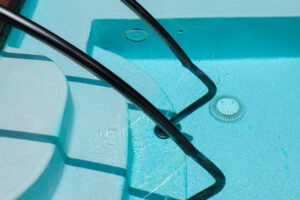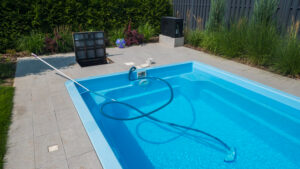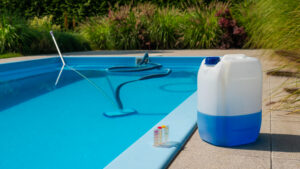Your pool pump works hard every day to keep water clean and clear. Like any machine, it needs regular care to avoid expensive breakdowns and high energy bills. Proper pool pump maintenance can extend your pump’s life by years while cutting energy costs and preventing costly repairs.
Most pool owners skip basic pump care until something goes wrong. This leads to emergency repair calls and replacement costs that could have been avoided. Simple weekly checks and seasonal maintenance tasks keep pumps running smoothly.
From cleaning pump baskets to checking water chemistry, small steps make a big difference. The right maintenance schedule also helps pumps start easier each season and run more efficiently year-round.
In this article, you’ll learn how to perform effective pool pump maintenance to extend pump life, lower energy bills, and avoid costly breakdowns.
Here’s what you need to know:
- What maintenance does a pool pump require
- Lubrication, noise, and motor care made simple
- Water chemistry habits that protect your pump
- When your pump needs servicing versus DIY
- Seasonal steps for smoother starts and lower bills
Keep reading! Understanding when to handle maintenance yourself versus calling a professional saves time and money.
What maintenance does a pool pump require
Pool pump maintenance involves three core areas: weekly visual inspections to catch issues early, proper care of baskets and seals to reduce noise and wear, and regular monitoring of prime, pressure, and flow to ensure optimal performance.
The five minute weekly check that prevents surprise failures
Pool owners should perform a quick visual inspection every week to spot problems before they become expensive repairs. This simple check takes only five minutes but can save hundreds of dollars in emergency service calls.
Start by listening to the pump motor. A healthy pump runs quietly with a steady hum. Grinding, squealing, or irregular sounds indicate worn bearings or debris in the impeller.
Check for water leaks around the pump housing and plumbing connections. Even small drips can signal seal failure that will worsen over time.
Look at the pump basket through the clear lid. The basket should be free of debris and the water level should reach the top. Low water levels suggest suction problems.
Weekly inspection checklist:
- Listen for unusual motor sounds
- Check for water leaks
- Verify proper water level in pump basket
- Look for debris around pump area
- Confirm pump is running at scheduled times
Basket, lid o ring, and seal care for quieter operation
The pump basket requires cleaning once or twice per week depending on pool usage and debris levels. A clogged basket reduces water flow and forces the motor to work harder.
Turn off the pump before removing the basket. Clean out leaves, hair, and other debris with a garden hose. Replace cracked or warped baskets immediately as they can allow debris into the impeller.
The lid O-ring creates a watertight seal that maintains proper suction. Clean the O-ring weekly with a damp cloth to remove dirt and pool chemicals. Apply a thin layer of silicone lubricant every month to keep it flexible.
Replace the O-ring annually or when it becomes hard, cracked, or loses its shape. A damaged O-ring causes air leaks that reduce pump efficiency and create loud gurgling sounds.
O-ring maintenance steps:
- Remove and clean with water
- Apply thin layer of silicone lubricant
- Check for cracks or hardening
- Replace annually
Prime, pressure, and flow checks that spot problems early
Pool pumps must maintain proper prime to function correctly. Check the pump basket weekly to ensure it stays full of water during operation. Air bubbles in the basket indicate suction leaks that need immediate attention.
Monitor the pressure gauge on your filter system. Normal operating pressure varies by filter type but typically ranges from 10-25 PSI when clean. Record your baseline pressure when the filter is newly cleaned or replaced.
Pressure warning signs:
- High pressure (8-10 PSI above normal): Dirty filter needs cleaning
- Low pressure (5+ PSI below normal): Suction leak or clogged pump basket
- Rapid pressure changes: Possible equipment malfunction
Check water flow at pool returns monthly. Weak flow indicates clogged baskets, dirty filters, or pump problems. Strong, steady flow shows the system is working properly.
Test pump priming after any maintenance work. The pump should achieve full prime within 2-3 minutes of startup. Extended priming times suggest air leaks or worn seals that need professional attention.
Lubrication, noise, and motor care made simple
Pool pump motors need specific lubrication care, while excessive noise often signals maintenance issues that can damage bearings. Proper airflow and cooling prevent heat damage that shortens motor life.
Do pool pumps need to be oiled or just the o ring
Most modern pool pump motors contain permanently sealed bearings that never need lubrication. Adding oil to these motors can damage rubber seals and attract dirt.
Motor bearings come pre-lubricated from the factory. The double-sealed design keeps lubricant inside and water out. If bearings fail, replacement is the only solution.
O-rings require regular lubrication to maintain proper seals. Pool owners should use Teflon-based lubricant designed specifically for pool equipment. Standard petroleum products can damage rubber components.
The pump lid o-ring needs the most attention. A dry o-ring allows air leaks that reduce pump efficiency. Pool owners should apply a thin layer of pool-safe lubricant every few months.
What to avoid:
- Motor oil or WD-40 on pump motors
- Over-lubricating o-rings
- Using automotive greases
Check o-rings during regular maintenance. Replace cracked or stretched rings immediately to prevent air leaks and pump damage.
Motor noise and vibration fixes for longer bearing life
Unusual pump noise indicates problems that can destroy bearings quickly. Early detection and fixes prevent expensive motor replacement.
Common noise causes:
- Loose mounting bolts
- Debris in pump basket
- Worn bearings
- Cavitation from air leaks
Tighten all pump mounting hardware monthly. Loose pumps vibrate excessively and damage bearings through constant movement.
Clean pump baskets weekly to prevent debris from unbalancing the impeller. Even small leaves can cause vibration that travels through the entire motor assembly.
Air leak symptoms include gurgling sounds and reduced water flow. Check pump lid tightness and o-ring condition. Lubricate o-rings and replace damaged ones immediately.
Cavitation creates a distinctive rattling noise when the pump cannot get enough water. This condition damages impellers and bearings rapidly.
Listen for changes in pump sound during operation. New noises require immediate investigation to prevent bearing failure.
Cooling airflow and shade tips that reduce heat stress
Pool pump motors generate significant heat during operation. Proper cooling extends motor life and prevents thermal damage to internal components.
Airflow requirements are critical for motor cooling. Keep vents clear of leaves, grass clippings, and debris. Blocked vents cause overheating within minutes.
Position pumps in shaded areas when possible. Direct sunlight raises motor temperature beyond safe operating limits during hot weather.
Clearance guidelines:
- 12 inches minimum around motor vents
- 18 inches above motor housing
- 6 inches between pump and walls
Install shade structures over exposed pumps. Simple wooden covers or awnings reduce heat stress significantly. Ensure covers allow airflow around the motor.
Clean motor housing monthly during swimming season. Dirt buildup acts as insulation that traps heat inside the motor.
Check motor temperature regularly by touch. Motors should feel warm but not too hot to handle. Excessive heat indicates ventilation problems or internal damage.
Water chemistry habits that protect your pump
Proper water chemistry protects pool pumps from premature failure by preventing corrosion, scale buildup, and excessive wear on seals and gaskets. Maintaining balanced pH, alkalinity, and calcium hardness reduces strain on pump components and extends equipment life.
The 3 C’s of pool maintenance and why they matter for equipment
The three critical elements of pool chemistry are chlorine, pH control, and calcium hardness. These factors directly impact pump longevity and performance.
Chlorine levels should stay between 1.0-3.0 ppm. Too little chlorine allows algae growth that clogs impellers and creates extra workload. Too much chlorine accelerates rubber seal deterioration.
pH levels must remain between 7.2-7.6. Low pH creates acidic water that eats away at metal pump components. High pH causes scale formation on impellers and reduces water flow efficiency.
Calcium hardness should measure 150-300 ppm. Low calcium makes water aggressive and dissolves pump housing materials. High calcium creates scale deposits that block water passages and overheat motors.
Test these levels twice weekly during swimming season. Adjust chemicals gradually to avoid shocking pump seals with sudden chemical changes.
How imbalance accelerates corrosion and seal wear
Chemical imbalances attack pump components in specific ways that lead to expensive repairs or replacements.
Acidic water (pH below 7.0) dissolves metal fittings, pump housings, and heat exchangers. Bronze and copper components suffer first, followed by stainless steel parts.
Alkaline conditions (pH above 8.0) cause calcium carbonate deposits on impellers and volutes. These deposits reduce water flow and create hot spots that crack pump housings.
High sanitizer levels break down rubber O-rings, gaskets, and mechanical seals. Pool owners often see black rubber pieces in skimmer baskets when seals fail.
Low alkalinity below 80 ppm makes pH bounce rapidly. This constant pH swing stresses all pump materials and shortens equipment life.
Salt corrosion affects saltwater pools differently. High salt concentrations attack metal components even when pH stays balanced. Inspect metal fittings monthly for white corrosion buildup.
Filter backwash timing that keeps head pressure in range
Dirty filters force pumps to work harder and increase system pressure. This extra strain shortens pump motor life and wastes energy.
Monitor pressure gauges on filter systems weekly. Clean or backwash filters when pressure rises 8-10 psi above the clean starting pressure.
Cartridge filters need cleaning every 2-4 weeks during peak season. Rinse with garden hose first, then soak in filter cleaner solution quarterly.
Sand filters require backwashing when flow decreases noticeably. Run backwash cycle until water runs clear, typically 2-3 minutes.
DE filters need backwashing monthly or when pressure builds up. Add fresh DE powder after each backwash cycle to maintain filtration quality.
Clogged filters create back pressure that damages pump seals and overheats motors. Replace filter media annually even with regular cleaning to maintain proper water flow.
When your pump needs servicing versus DIY
Pool pump problems range from simple fixes any homeowner can handle to complex repairs requiring professional expertise. Knowing when to tackle maintenance yourself versus calling a technician can save both money and prevent costly equipment damage.
Do pool pumps need servicing and what a tune up includes
Pool pumps require regular servicing to maintain proper water circulation and prevent breakdowns. Most pumps benefit from professional tune-ups once or twice per year.
A standard pool pump tune-up includes several key services. Technicians inspect the pump motor, impeller, and housing for wear or damage. They check all seals and gaskets for leaks.
The pump basket gets cleaned thoroughly. Pool professionals also examine electrical connections for corrosion or loose wires. They test the motor’s amp draw to ensure it runs efficiently.
Basic DIY maintenance tasks include:
- Cleaning the pump basket weekly
- Checking water levels in the skimmer
- Listening for unusual noises
- Monitoring pressure gauge readings
Professional servicing becomes necessary when pumps show signs of decreased performance. Technicians have specialized tools to measure motor efficiency and diagnose internal problems that homeowners cannot detect.
Leaks, overheating, and tripping breakers and when to call a pro
Certain pump problems signal the need for immediate professional attention. These issues can cause expensive damage if handled incorrectly.
Water leaks around the pump housing indicate seal failure. Small drips might seem harmless but can worsen quickly. Professional repair prevents motor damage from water infiltration.
Overheating motors shut down repeatedly to protect internal components. This usually means blocked ventilation, worn bearings, or electrical problems. Attempting DIY repairs on overheating pumps risks electrocution or fire.
Tripping circuit breakers suggest electrical faults within the motor or wiring. Pool owners should never attempt electrical repairs on pump systems. Licensed electricians or pool technicians must handle these repairs safely.
| Problem | DIY Safe? | Professional Required |
| Water leaks | No | Yes – seal replacement |
| Motor overheating | No | Yes – electrical diagnosis |
| Breaker trips | No | Yes – electrical repair |
| Strange noises | Maybe | Yes if persistent |
These problems can escalate from minor issues to complete pump failure within days.
Repair or replace and how age and efficiency guide the choice
The decision between repairing or replacing a pool pump depends on age, repair costs, and energy efficiency. Pumps older than 8-10 years often cost more to repair than replace.
Repair makes sense when:
- The pump is less than 5 years old
- Repair costs under 50% of replacement price
- Only minor components need fixing
- The motor still runs efficiently
Replacement becomes necessary when:
- Multiple components fail simultaneously
- Motor efficiency drops significantly
- Repair costs exceed 60% of new pump price
- Parts become difficult to find
Modern variable-speed pumps use 50-80% less energy than older single-speed models. Energy savings often justify replacement even when repairs remain possible.
As stated by the U.S. Department of Energy, using an ENERGY STAR certified pool pump can save more than $300 over the equipment’s lifetime, and to ENERGY STAR, certified in-ground pool pumps use about 20% less energy than standard models, saving pool owners approximately $50 each year.
Pool professionals can measure actual energy consumption and calculate payback periods. They also ensure proper sizing for the pool’s circulation needs.
Cost comparison factors:
- Labor costs: $150-300 for repairs vs $200-400 for installation
- Part costs: Seals ($20-50) vs motors ($200-600)
- Energy savings: $300-800 annually with efficient pumps
Warranty coverage also influences the repair versus replace decision for newer equipment.
Seasonal steps for smoother starts and lower bills
Proper seasonal maintenance prevents costly breakdowns and reduces energy costs by up to 30%. Winter protection stops freeze damage while spring prep ensures quick startup and optimal pump performance year-round.
Off season storage and freeze protection that save repairs
Pool owners in cold climates must drain their pump completely before winter arrives. Water left inside can freeze and crack the pump housing or impeller.
Winter drainage steps:
- Remove drain plugs from pump housing
- Take out pump basket and clean thoroughly
- Store removable parts in a dry location
- Cover pump motor with waterproof material
For pools that run year-round, insulation wraps protect pipes and equipment. Freeze sensors automatically start pumps when temperatures drop below 32°F.
Pool owners should also check valve positions before winter. All valves should point to drain or winter positions to prevent water buildup.
Spring startup checklist for fast, reliable priming
Spring startup requires careful inspection before turning on the pump. A rushed startup can damage equipment that sat unused for months.
Pre-startup inspection:
- Check all connections for cracks or loose fittings
- Replace pump basket if cracked or warped
- Inspect impeller for debris or damage
- Verify all drain plugs are tight
Priming procedure:
- Fill pump basket housing with water
- Replace lid with new O-ring if needed
- Open all valves slowly
- Start pump and watch for steady flow
Low water levels prevent proper priming. Pool owners should fill their pool to mid-skimmer level before starting the pump.
Variable speed settings that cut energy use without losing flow
Variable speed pumps use 65-80% less energy than single speed models. Different pool tasks need different speeds for maximum efficiency.
Optimal speed settings:
- Filtration: 1,200-1,500 RPM for 8-10 hours daily
- Skimming: 2,400 RPM for 2-3 hours during peak debris times
- Cleaning: 3,000+ RPM only when vacuuming
Pool owners should run pumps during off-peak electricity hours when rates are lowest. Most utilities charge less between 9 PM and 6 AM.
Timer controls automate speed changes throughout the day. This prevents manual adjustments and ensures consistent energy savings.
Proper flow rates maintain water quality while minimizing costs. Pool owners can reduce speeds gradually until they notice decreased water clarity, then increase slightly.
Conclusion
Pool pump maintenance protects one of the most important parts of any swimming pool system. Regular care keeps the water clean and safe for swimming.
A well-maintained pump lasts longer and costs less to run. It also prevents expensive repairs and sudden breakdowns.
Pool owners who follow basic maintenance steps see better results. Their pumps work better and use less energy.
The pump basket needs cleaning most often. This simple task takes just a few minutes each week.
Professional service helps with bigger maintenance jobs. Most pumps need expert attention once or twice per year.
Pool owners should watch for warning signs like strange noises or weak water flow. Early action prevents bigger problems.
Regular maintenance is easier than dealing with a broken pump. A few simple steps each month keep everything running smoothly.
Good maintenance habits start from day one. Pool owners who begin early get the best results from their equipment.







